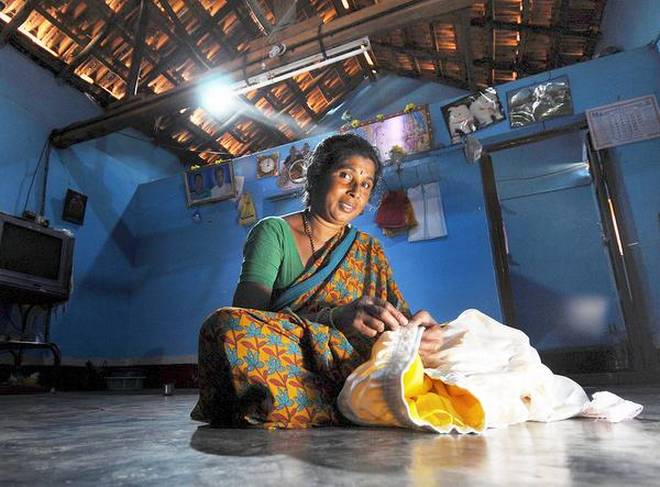Bengaluru’s textile industry is headed back to the hinterland.
Twelve years ago, Gowramma arrived in Bengaluru with a tin suitcase. It contained two saris and her husband and three children’s clothes. The family had travelled from Mandya district in search of jobs in the state capital. After several failed attempts at finding work, Gowramma was finally recruited by a textile factory. Her husband managed to sell miscellaneous items on a pushcart. Since her income was significantly higher than his, and more stable, it became her responsibility to pay the rent and school fees.
For the next 10 years Gowramma worked as a semi-skilled labourer at garment factories in Bengaluru. She worked six days a week, 10 hours a day. Falling ill meant salary cuts.
Today, she continues to work in the garment industry, but with one fundamental difference: She lives in her own house in Chanagalu, 15 kilometres from Mandya city. “I love to see the lush fields here,” she said, “the thing I missed the most in Bengaluru.” The cost of living is much lower too, she adds. Her life is still far from rosy. She lives in a one-room house and spends Rs. 50 a day from her meagre monthly salary of Rs. 6,500 to commute to the factory. But she is far happier than before.
Gowramma’s family decided to return to Mandya a year ago. Her children were grown up and Bengaluru’s rents had skyrocketed. Luckily for her, since 2009, soaring costs and labour paucity has been pushing textile companies into smaller towns. So Gowramma got to keep her job. The trend has been so widespread that the garment workers’ trade union believes the industry may all but cease to exist in Bengaluru in a few years.
“The industry was established in Bengaluru because it was a city that was easy to migrate to. And now the industry is moving out because it has become so difficult here,” says Jayaram A.H., president, Garment and Textile Workers Union (GATWU).
Bengaluru is one of three textile hubs in the country, the others being Gurgaon in Haryana and Tirupur in Tamil Nadu. Karnataka’s capital caters to top international brands including Gap, H&M, Old Navy, Banana Republic and J.C. Penney.
Criticised for focusing exclusively on urban areas, the Karnataka government, by 2009, had begun subsidising water, land and electricity for industries in smaller districts. And so the seeds were sown for these new hubs outside Bengaluru. Setting up garment factories in smaller towns meant training a new crop of workers. But when factories moved to the districts around Bengaluru, most women migrated right back to their home towns and villages. There are currently more than 100 factories, small and big, in Ramanagara, Mandya, Mysuru, Bhadravati (Shivamogga), Tumakuru and Kolar. The majority, however, close to 900, remains in Bengaluru, although those too may find it profitable to move in future.
According to GATWU’s estimates, close to five lakh women in Karnataka work in textile factories under harsh conditions. A report by the Indian Committee for the Netherlands (a human rights organisation), published earlier this year, described the hardships the women face in factories and hostels in Bengaluru: production targets are inhuman, movement is restricted, wages are low and the incidence of sexual harassment is high. “Who would want to work in such conditions? Only those who have seen worse,” says Pratibha, a member of GATWU. For these women, working in their home towns is a far better option. Now, Bengaluru’s textile factories are peopled by women from Odisha, Jharkhand, Maharashtra, Madhya Pradesh and Uttar Pradesh, who have migrated here in search of work.
Rama Devi, who migrated from Bengaluru to her home town of Tumakuru two years ago, says she is more “at ease” here. “Even though I lived in Bengaluru for more than 12 years, it was never home. My parents lived here and everyone recognised them. Now, everyone recognises us. Tumakuru is also affordable for us.”
The workers are happy to be back home, but there is also the fear that the industry’s geographical diffusion might weaken the labour union, which has been responsible for ensuring a minimum wage and addressing sexual harassment at the workplace. In semi-urban parts of Ramanagara district, for instance, where a strong community network is absent, workers like Sharada feel the need for a union. “We are beginning to live fragmented lives where one doesn’t care much for one’s neighbour. We will benefit a great deal from a union here,” says Sharada, who works for Shah Exports.
But one thing is clear: the fabric of the garment industry in Karnataka is fast changing, and many workers are finding comfort and opportunities back in the homes they once left behind.
Published in: The Hindu
Published on: 10 December, 2016
Link: http://www.thehindu.com/society/A-changing-fabric/article16783371.ece


